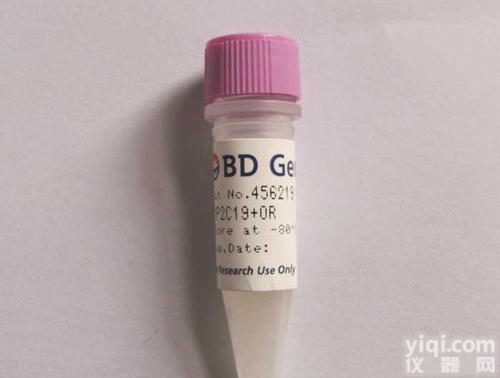本公司经销Ubiquityl Histone H2A.X (Lys119),泛素化组蛋白H2AX抗体,克隆类型为polyclonal,宿主来源是Rabbit,Ubiquityl Histone H2A.X (Lys119)泛素化组蛋白H2AX抗体可应用于WB、elisa、IP、IF、IHC等实验,欢迎垂询订购!
本公司经销Ubiquityl Histone H2A.X (Lys119),泛素化组蛋白H2AX抗体,克隆类型为polyclonal,宿主来源是Rabbit,Ubiquityl Histone H2A.X (Lys119)泛素化组蛋白H2AX抗体可应用于WB、elisa、IP、IF、IHC等实验,欢迎垂询订购!
货号:BY-8571R
英文名称:Anti-Ubiquityl Histone H2A.X (Lys119)
中文名称:泛素化组蛋白H2AX抗体
其他名称:名Ubiquityl-Histone H2A (Lys119); U-H2afx(Lys119); H2A histone family member X; H2A.FX; H2A.X; H2A/X; H2AFX; H2AX; H2AX histone; H2AX_HUMAN; Hist5.2ax; Histone 2A; Histone 2AX; Histone H2A.x; RGD1566119.
抗体来源:Rabbit
克隆类型:polyclonal
蛋白分子量:predicted molecular weight: 16kDa
纯化方法:affinity purified by Protein A
交叉反应:hu, pig, cow, rat, Rb
产品介绍:Histone H2A.X is a member of the Histone H2A family, which is involved in nucleosomal organization of chromatin. The nucleosome, made up of four core histone proteins (H2A, H2B, H3, and H4), is the primary building block of chromatin. Originally thought to function as a static scaffold for DNA packaging, histones have now been shown to be dynamic proteins, undergoing multiple types of post-translational modifications, including acetylation, phosphorylation, methylation, and ubiquitination Ubiquitin is a conserved 76 amino acid peptide unit that can be covalently linked to many cellular proteins by the ubiquitination process. Three components are involved in this protein-ubiquitin conjugation process. Ubiquitin is first activated by forming a thioester complex with the activation component E1; the activated ubiquitin is subsequently transferred to the ubiquitin-carrier protein E2, then from E2 to ubiquitin ligase E3 for final delivery to the epsilon-NH2 of the target protein lysine residue. Histone H2A is mono-ubiquitinated at Lys119 by the Polycomb Repressor Complex 1 (PRC1) and is critical for transcriptional silencing of the developmental HOX genes and X chromosome inactivation . PRC1 is composed of Bmi1 and RING1A (also RING1 or RNF1), both of which act to enhance the E3 ubiquitin ligase activity of the catalytic subunit RING1B (also RING2 or RNF2) . Histone H2A is also mono-ubiquitinated at Lys119 at sites of DNA damage. This mono-ubiquitination event requires the PRC1 components Bmi1 and RING1B, in addition to another E3 ubiquitin ligase RNF8, and contributes to subsequent recruitment of the BRCA1 complex, via binding of RAP80/UIMC1 (ubiquitin interactive motif containing 1 protein).Function : Variant histone H2A which replaces conventional H2A in a subset of nucleosomes. Nucleosomes wrap and compact DNA into chromatin, limiting DNA accessibility to the cellular machineries which require DNA as a template. Histones thereby play a central role in transcription regulation, DNA repair, DNA replication and chromosomal stability. DNA accessibility is regulated via a complex set of post-translational modifications of histones, also called histone code, and nucleosome remodeling. Required for checkpoint-mediated arrest of cell cycle progression in response to low doses of ionizing radiation and for efficient repair of DNA double strand breaks (DSBs) specifically when modified by C-terminal phosphorylation.Subunit : The nucleosome is a histone octamer containing two molecules each of H2A, H2B, H3 and H4 assembled in one H3-H4 heterotetramer and two H2A-H2B heterodimers. The octamer wraps approximately 147 bp of DNA. Interacts with numerous proteins required for DNA damage signaling and repair when phosphorylated on Ser-140. These include MDC1, TP53BP1, BRCA1 and the MRN complex, composed of MRE11A, RAD50, and NBN. Interaction with the MRN complex is mediated at least in part by NBN. Also interacts with DHX9/NDHII when phosphorylated on Ser-140. Interacts with ARRB2; the interaction is detected in the nucleus upon OR1D2 stimulation.Subcellular Location : Nucleus. Chromosome.Post-translational modifications : Monoubiquitination of Lys-120 (H2AXK119ub) by RING1 and RNF2/RING2 complex gives a specific tag for epigenetic transcriptional repression. Following DNA double-strand breaks (DSBs), it is ubiquitinated through 'Lys-63' linkage of ubiquitin moieties by the E2 ligase UBE2N and the E3 ligases RNF8 and RNF168, leading to the recruitment of repair proteins to sites of DNA damage. Monoubiquitination and ionizing radiation-induced 'Lys-63'-linked ubiquitination are distinct events.Acetylation at Lys-37 increases in S and G2 phases. This modification has been proposed to play a role in DNA double-strand break repair.Similarity : Belongs to the histone H2A family.
 Ubiquityl Histone H2A.X (Lys119)泛素化组蛋白H2AX抗体
Ubiquityl Histone H2A.X (Lys119)泛素化组蛋白H2AX抗体
 Ubiquityl Histone H2A.X (Lys119) 泛素化组蛋白H2AX抗体
Ubiquityl Histone H2A.X (Lys119) 泛素化组蛋白H2AX抗体
 Ubiquityl Histone H2A.X (Lys119) 泛素化组蛋白H2AX抗体
Ubiquityl Histone H2A.X (Lys119) 泛素化组蛋白H2AX抗体
 Ubiquityl Histone H2A.X (Lys119) 泛素化组蛋白H2AX抗体
Ubiquityl Histone H2A.X (Lys119) 泛素化组蛋白H2AX抗体
 Ubiquityl Histone H2A.X (Lys119) 泛素化组蛋白H2AX抗体
Ubiquityl Histone H2A.X (Lys119) 泛素化组蛋白H2AX抗体
 皮屑样蛋白2抗体,瘦素受体抗体,瘦素抗体,LETM1蛋白抗体,桩蛋白抗...
皮屑样蛋白2抗体,瘦素受体抗体,瘦素抗体,LETM1蛋白抗体,桩蛋白抗...
 KNCN蛋白抗体,脑蛋白9抗体,着丝点关联蛋白1抗体,角蛋白相关蛋白1...
KNCN蛋白抗体,脑蛋白9抗体,着丝点关联蛋白1抗体,角蛋白相关蛋白1...
 LRPAP1抗体,脂蛋白受体相关蛋白/低密度脂蛋白相关蛋白的相关蛋白1抗体
LRPAP1抗体,脂蛋白受体相关蛋白/低密度脂蛋白相关蛋白的相关蛋白1抗体
 LRPAP1抗体,脂蛋白受体相关蛋白/低密度脂蛋白相关蛋白的相关蛋白1抗体FITC.PE
LRPAP1抗体,脂蛋白受体相关蛋白/低密度脂蛋白相关蛋白的相关蛋白1抗体FITC.PE
 亲脂性蛋白B抗体,脂蛋白脂酶抗体,促脂素gamma抗体,凋亡YZ蛋白抗...
亲脂性蛋白B抗体,脂蛋白脂酶抗体,促脂素gamma抗体,凋亡YZ蛋白抗...
 Anti-LRPAP1/MRAP抗体脂蛋白受体相关蛋白/低密度脂蛋白相关蛋白的相关蛋白1抗体
Anti-LRPAP1/MRAP抗体脂蛋白受体相关蛋白/低密度脂蛋白相关蛋白的相关蛋白1抗体
 LRPAP1抗体 脂蛋白受体相关蛋白/低密度脂蛋白相关蛋白的相关蛋白1抗体
LRPAP1抗体 脂蛋白受体相关蛋白/低密度脂蛋白相关蛋白的相关蛋白1抗体